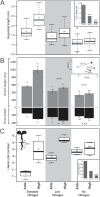Phytochrome B regulates resource allocation in Brassica rapa
- PMID: 29514292
- PMCID: PMC5961229
- DOI: 10.1093/jxb/ery080
Phytochrome B regulates resource allocation in Brassica rapa
Abstract
Crop biomass and yield are tightly linked to how the light signaling network translates information about the environment into allocation of resources, including photosynthates. Once activated, the phytochrome (phy) class of photoreceptors signal and re-deploy carbon resources to alter growth, plant architecture, and reproductive timing. Most of the previous characterization of the light-modulated growth program has been performed in the reference plant Arabidopsis thaliana. Here, we use Brassica rapa as a crop model to test for conservation of the phytochrome-carbon network. In response to elevated levels of CO2, B. rapa seedlings showed increases in hypocotyl length, shoot and root fresh weight, and the number of lateral roots. All of these responses were dependent on nitrogen and polar auxin transport. In addition, we identified putative B. rapa orthologs of PhyB and isolated two nonsense alleles. BrphyB mutants had significantly decreased or absent CO2-stimulated growth responses. Mutant seedlings also showed misregulation of auxin-dependent genes and genes involved in chloroplast development. Adult mutant plants had reduced chlorophyll levels, photosynthetic rate, stomatal index, and seed yield. These findings support a recently proposed holistic role for phytochromes in regulating resource allocation, biomass production, and metabolic state in the developing plant.
Figures




References
-
- Aerts R, de Caluwe H, Konings H. 1992. Seasonal allocation of biomass and nitrogen in four carex species from mesotrophic and eutrophic fens as affected by nitrogen supply. Journal of Ecology 80, 653–664.
-
- Ainsworth EA, Long SP. 2005. What have we learned from 15 years of free-air CO2 enrichment (FACE)? A meta-analytic review of the responses of photosynthesis, canopy properties and plant production to rising CO2. New Phytologist 165, 351–371. - PubMed
-
- Alvarez JM, Vidal EA, Gutiérrez RA. 2012. Integration of local and systemic signaling pathways for plant N responses. Current Opinion in Plant Biology 15, 185–191. - PubMed
-
- Anderson LJ, Derner JD, Polley HW, Gordon WS, Eissenstat DM, Jackson RB. 2010. Root responses along a subambient to elevated CO2 gradient in a C3–C4 grassland. Global Change Biology 16, 454–468.
Publication types
MeSH terms
Substances
LinkOut - more resources
Full Text Sources
Other Literature Sources

